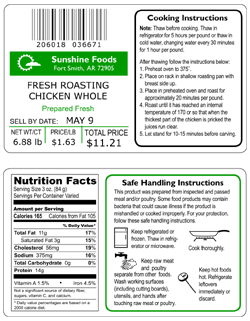|
Reading the label will inform you as to the type of chicken, the parts contained in the package, the total weight, a description, how fresh it is, and nutritional information. The type of chicken indicates whether it is a young or old chicken, which signifies its tenderness and suggests what cooking methods are most suitable. Boiler/fryers, roasters, capons, and Cornish hens are considered young birds, indicating that they are more tender and suitable for most any cooking method. They are a good choice for grilling, broiling, frying, and roasting. The more mature chickens, such as stewing chickens and hens, have meat that is tougher, which benefits from a moist-heat cooking method, such as stewing, braising, poaching, and steaming. Many times the meat from more mature chickens is used for soups, salads, sandwiches, or is added as an ingredient in other dishes.
 |
|
The label will show the cut of chicken contained in the package and the total weight. From this information you can determine whether it contains white meat, dark meat or both. It will allow you to determine what quantity you will need to buy according to the weight contained in the packages. The label should indicate if the chicken is boneless or skinless.
The label on fresh chicken will have a "sell-by date" printed on it, which is the date seven to ten days after it was slaughtered. It represents the last day recommended for selling the product. Generally the store will pull any products left on the shelf the day of the "sell-by date". If the chicken is properly refrigerated, it will remain fresh up to three days after the "sell-by date", but if it is not to be used within that time, it should be frozen. |
|
Some labels may have a "use-by date" rather than a "sell-by date", which means fresh chicken should be cooked or frozen by that date. If the chicken is precooked, it should be eaten by the "use-by date."
The nutritional value of the chicken will also be shown on the label. The label will show calories, fat and cholesterol content, and it will list the nutrients contained. The label may also contain information such as cooking instructions, food safety, and handling instructions. |
|

